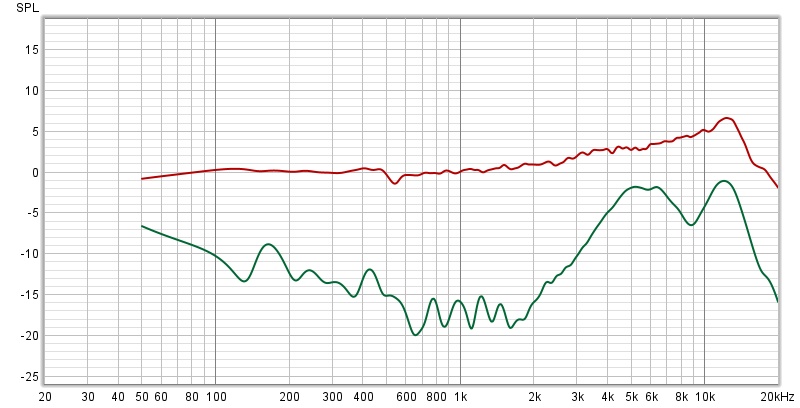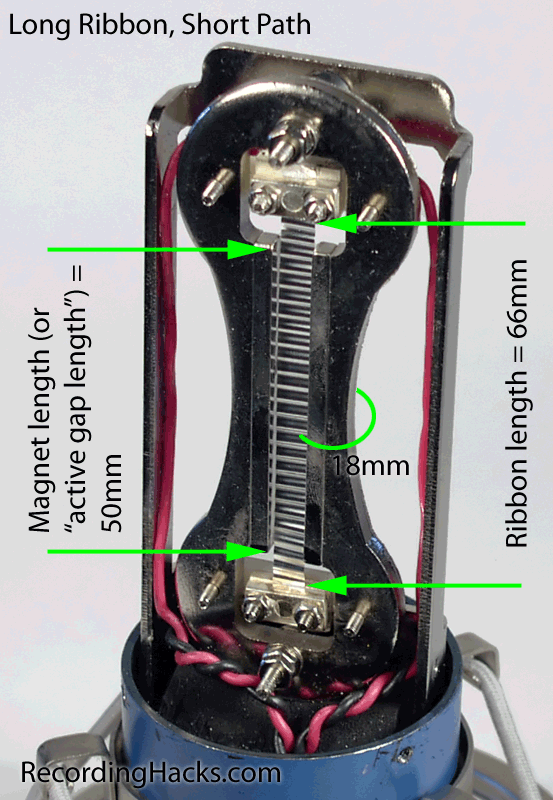I've been thinking about sharing this for a while now as i've never read anything about this before. Please understand that there are exceptions, and if you like using your favorite LDC in figure of eight (or omni) there is nothing wrong with that, but you might want to understand what is really going on.
I almost never use multi pattern mics. There are several things happening at the same time, so i'll try to break them down.
The first issue is something I call ''electrical polar pattern fighting the mechanical one''. The other issue is the fact that sound is picked up by two membranes spaced apart by the thickness of the backplate. So you get phasing issues.
Electrical polar pattern fighting the mechanical one.
Let's take double sided/dual membrane K67(or k47, c12) capsule as example. Now imagine only one side is active, the other is not and for all intents and purposes doesn't exist in cardioid mode. You get frequency response like this:

We are interested in the green line which is 180 degree response. Most people think of cardioids as if they reject everything coming from the rear. This couldn't be further from the truth. 180 degree response is just 5 db bellow the 0 degree response at 5K where our ears are quite sensitive. This 180 degree response is created by the sound hitting the FRONT diaphragm coming through the mechanical delay network of the capsule's backplate, and not the REAR diaphragm which is in this mode disabled.
Now imagine we activate the rear diaphragm in such manner that we form figure of eight pattern. And we do get indeed, with an ideal capsule, F8 pattern with identical responses. The sound coming from each side of the capsule is now dominated by the sound coming from both physical diaphragms. We have achieved this by applying polarization voltage, and now both diaphragms are engaged. But what happened to that green 180 degree response we had in the previous image which was created by the sound coming through the rear diaphragm and the backplate and eventually hit the front diaphragm in opposite phase? Did it disappear? Well that's the thing people don't usually think about. It is still here, masked by the electrical signal created by the rear diaphragm. It is still just -5db at 5K, and it is mixed with the electrical signal. However it is PHASE SHIFTED by the distance between the diaphragms (approximately backplate thickness)!!! Of course this is true for the sound coming from both sides, there is no front or rear diaphragm per se, the capsule is symmetrical.
The issue of two diaphragms
This is basically explained above, but to simplify it even further, by using double sided capsule you actually have two microphones facing in opposite directions, however due to the capsule nature they are always somewhat phase shifted due to diaphragm separation. If you line up two mics as close as possible for any source in front of them, why would you do it any different in this case? Ideally you wouldn't, the same principle applies. Which brings me to the point. See how simple and elegant construction of a ribbon mic is. One ribbon, symmetrical construction, the sound coming from all around is hitting the diaphragm (the ribbon) at the same time, no delay of any sorts, no backplate in between, and no ''electrical'' signal messing with the ''mechanical''.

The same really goes for omni mode, or any pattern in between.
There is also one more issue with a lot of multi pattern mics. The electrical paths from the front and back diaphragm of the capsule to the impedance converter are rarely identical. Which can make all sorts of issues, mediocre both polar and frequency responses for example. In some, quite common topologies, one side of the capsule can stay charged even though the pattern is changed, which could mean you are using some random pattern between F8 and omni without realizing, yet thinking you are in cardioid.
If I want F8 response I simply use a ribbon mic. If I want omni, I just go for omni mic which utilizes one diaphragm. There are some different, yet exotic solutions, special capsule designs that try to avoid these issues. I personally use, if I have to, dual out mics such as Townsend Labs Sphere which allow me to virtually move diaphragms closer to each other by time aligning signals. The electronic path from both sides is also identical. But again, it will never give me phase coherent signal as ribbon or omni mics.
2023 update with measurement where two of the diaphragms are virtually aligned in omni to showcase the described issue:
Why you should never use multi pattern mics
I almost never use multi pattern mics. There are several things happening at the same time, so i'll try to break them down.
The first issue is something I call ''electrical polar pattern fighting the mechanical one''. The other issue is the fact that sound is picked up by two membranes spaced apart by the thickness of the backplate. So you get phasing issues.
Electrical polar pattern fighting the mechanical one.
Let's take double sided/dual membrane K67(or k47, c12) capsule as example. Now imagine only one side is active, the other is not and for all intents and purposes doesn't exist in cardioid mode. You get frequency response like this:

We are interested in the green line which is 180 degree response. Most people think of cardioids as if they reject everything coming from the rear. This couldn't be further from the truth. 180 degree response is just 5 db bellow the 0 degree response at 5K where our ears are quite sensitive. This 180 degree response is created by the sound hitting the FRONT diaphragm coming through the mechanical delay network of the capsule's backplate, and not the REAR diaphragm which is in this mode disabled.
Now imagine we activate the rear diaphragm in such manner that we form figure of eight pattern. And we do get indeed, with an ideal capsule, F8 pattern with identical responses. The sound coming from each side of the capsule is now dominated by the sound coming from both physical diaphragms. We have achieved this by applying polarization voltage, and now both diaphragms are engaged. But what happened to that green 180 degree response we had in the previous image which was created by the sound coming through the rear diaphragm and the backplate and eventually hit the front diaphragm in opposite phase? Did it disappear? Well that's the thing people don't usually think about. It is still here, masked by the electrical signal created by the rear diaphragm. It is still just -5db at 5K, and it is mixed with the electrical signal. However it is PHASE SHIFTED by the distance between the diaphragms (approximately backplate thickness)!!! Of course this is true for the sound coming from both sides, there is no front or rear diaphragm per se, the capsule is symmetrical.
The issue of two diaphragms
This is basically explained above, but to simplify it even further, by using double sided capsule you actually have two microphones facing in opposite directions, however due to the capsule nature they are always somewhat phase shifted due to diaphragm separation. If you line up two mics as close as possible for any source in front of them, why would you do it any different in this case? Ideally you wouldn't, the same principle applies. Which brings me to the point. See how simple and elegant construction of a ribbon mic is. One ribbon, symmetrical construction, the sound coming from all around is hitting the diaphragm (the ribbon) at the same time, no delay of any sorts, no backplate in between, and no ''electrical'' signal messing with the ''mechanical''.

The same really goes for omni mode, or any pattern in between.
There is also one more issue with a lot of multi pattern mics. The electrical paths from the front and back diaphragm of the capsule to the impedance converter are rarely identical. Which can make all sorts of issues, mediocre both polar and frequency responses for example. In some, quite common topologies, one side of the capsule can stay charged even though the pattern is changed, which could mean you are using some random pattern between F8 and omni without realizing, yet thinking you are in cardioid.
If I want F8 response I simply use a ribbon mic. If I want omni, I just go for omni mic which utilizes one diaphragm. There are some different, yet exotic solutions, special capsule designs that try to avoid these issues. I personally use, if I have to, dual out mics such as Townsend Labs Sphere which allow me to virtually move diaphragms closer to each other by time aligning signals. The electronic path from both sides is also identical. But again, it will never give me phase coherent signal as ribbon or omni mics.
2023 update with measurement where two of the diaphragms are virtually aligned in omni to showcase the described issue:
Why you should never use multi pattern mics
Last edited:



